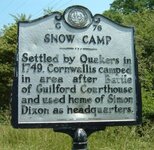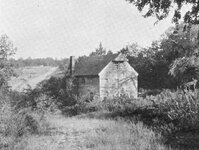Gypsy Heart
Gold Member
The Dixon Mill was in its day another interesting place at Snow Camp. It was built in 1753 by Simon Dixon and was the scene of General Cornwallis' encampment during the Revolutionary War. The British troops are said to have slaughtered seventy beeves in a nearby field, the meat being cut on the
benches taken from Cane Creek Church and rails from Simon Dixon's fences furnished fuel for camp fires and the millers house, built of stone, was Cornwallis' headquarters, the family having to procure other quarters. The British tried to start the grist mill and grind meal, but there was not a miller among
them. Other soldiers, so the story goes, thought Simon Dixon possessed money and tried vainly to force him to give it up by punching him with red hot tongs. These tongs are now in possession of a resident of the community.Dixons Mill was built on Cane Creek, which is said to have derived its name from the fact that the soil along the stream was found well adapted for growing sorghum cane." (By Ralph Johnson and published in a local newspaper in Alamance County, North Carolina)
-----
Dixon Mill
This dam still stands about .2 miles upstream of where Sylvan School Road crosses Cane Creek in Alamance County.
This mill was originally built by Simon Dixon in 1753. Dixon was one of many Pennsylvania Quakers who established mills across the piedmont of North Carolina (Centennial History of Alamance County). The mill is shown here by Ramsey (1870) and Spoon (1893) bearing the Dixon name.
/////////////////////
N 35° 53.467 W 079° 25.776
17S E 641736 N 3973010
The location of an early Quaker settlement and Revolutionary War site. This marker is on Snow Camp Road, just south of the Greensboro-Chapel Hill Road.
/////////////////////////////
http://www.stoppingpoints.com/north-carolina/sights.cgi?marker=Snow+Camp&cnty=Alamance
///////////////////////
benches taken from Cane Creek Church and rails from Simon Dixon's fences furnished fuel for camp fires and the millers house, built of stone, was Cornwallis' headquarters, the family having to procure other quarters. The British tried to start the grist mill and grind meal, but there was not a miller among
them. Other soldiers, so the story goes, thought Simon Dixon possessed money and tried vainly to force him to give it up by punching him with red hot tongs. These tongs are now in possession of a resident of the community.Dixons Mill was built on Cane Creek, which is said to have derived its name from the fact that the soil along the stream was found well adapted for growing sorghum cane." (By Ralph Johnson and published in a local newspaper in Alamance County, North Carolina)
-----
Dixon Mill
This dam still stands about .2 miles upstream of where Sylvan School Road crosses Cane Creek in Alamance County.
This mill was originally built by Simon Dixon in 1753. Dixon was one of many Pennsylvania Quakers who established mills across the piedmont of North Carolina (Centennial History of Alamance County). The mill is shown here by Ramsey (1870) and Spoon (1893) bearing the Dixon name.
/////////////////////
N 35° 53.467 W 079° 25.776
17S E 641736 N 3973010
The location of an early Quaker settlement and Revolutionary War site. This marker is on Snow Camp Road, just south of the Greensboro-Chapel Hill Road.
/////////////////////////////
http://www.stoppingpoints.com/north-carolina/sights.cgi?marker=Snow+Camp&cnty=Alamance
///////////////////////









